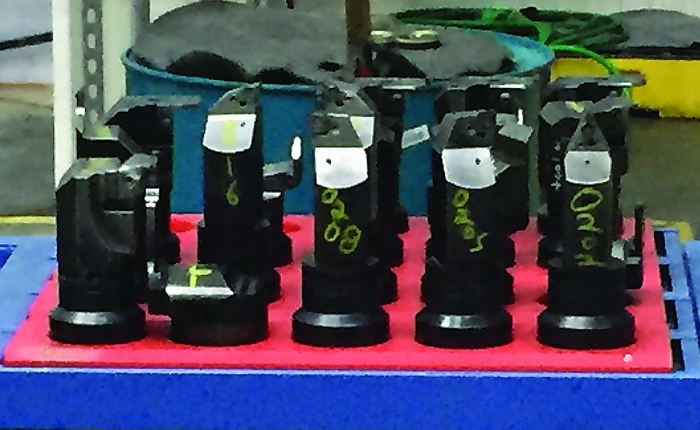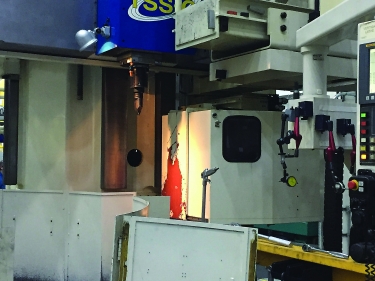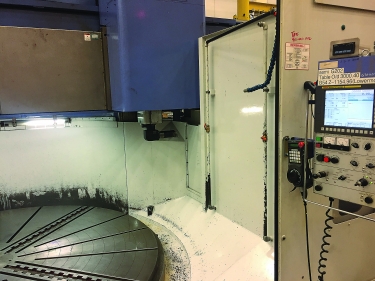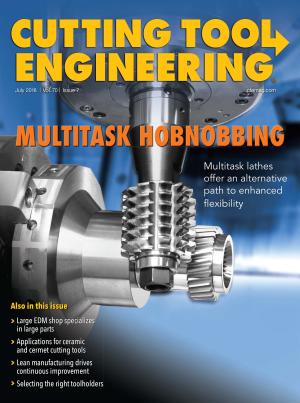I have been presented with countless varieties of toolholders over the years. All have been touted as cost-reducing or quality-improving products for reasons such as extended tool life, runout minimization and powerful gripping forces, among others. In some cases, the claims were accurate; in others, they were a bit exaggerated. I suspect that most shop owners, engineers and machinists can recount similar tales and claims.
Two things are certain: Opinions about toolholders and best practices are varied, and toolholders can consume a significant portion of a shop’s budget.

All images courtesy of Christopher Tate
So how does one sort through the selections and find the best solution in terms of costs? No formula or process will derive the best choice, but there are considerations that will help make sound decisions when selecting the best toolholders.
The Common Touch
First, strive to eliminate variation in styles and technology. Common holding methods will help reduce unnecessary inventory and make the shop far more flexible, especially when reacting to short-cycle jobs and emergent situations.
Moving jobs around the shop to address capacity or maintenance issues can be difficult when machines have dissimilar toolholding requirements. Work to create a shop that has common machine interfaces so tools can be moved from machine to machine with little effort. Consider, for example, a CAT 50 toolholder and a BT50 toolholder. They are interchangeable in the machine spindle, but they are not interchangeable in the automatic toolchanger.
Having a common machine tool interface also means toolholders are not made obsolete when a machine leaves the shop. I saw hundreds of toolholders leave in scrap bins as old machines became obsolete at an aerospace manufacturer. Most of the toolholders had almost no signs of wear and actually appeared new. They were discarded because they did not fit any of the other machines in the shop.
New and Proprietary Technologies
Avoid unproven technology. It is common for a sales representative to present a new toolholding system that has not been proven effective outside the manufacturer’s controlled environment. Always review new technologies carefully and consider how the change would impact commonality. Also, project the cost and availability of spare parts and wear items, like collets.
In addition, evaluate proprietary technologies carefully before adopting them. In some cases, you may be presented with a system that is not new but proprietary. This can limit access to parts and make you a victim of extended lead times when the manufacturer experiences interruptions to its production schedule. Proprietary technologies can also be limited by availability and minimal configurations.
Although there are negative aspects to adopting proprietary technology, when properly vetted, it can sometimes make sense to invest in proprietary or specialized toolholding systems.


Each machine has a set of custom toolholders that fit into the ram, allowing the use of standard Sandvik Coromant Capto indexable tools. Common toolholding allows jobs to be moved at will.
I once inherited responsibility for a vertical turret lathe after it had been purchased. It was my responsibility to install, tool up and commission the lathe. The tool interface on this VTL required a tapered holder like a machining center. Maintaining commonality with the other machines in the bay meant we needed to use Sandvik Coromant Capto-style toolholders for this machine. This decision made obsolete the handful of toolholders included with the machine, forcing us to purchase new ones.
Capto adapters are available for numerous spindle tapers; we expected to select from the catalog and have the necessary items in a few days. Unfortunately, the VTL spindle required a BT55 taper, which is not common. BT55 tapers are so uncommon that we spent an extra $75,000 on custom holders. We opted for the special holders so all the machines in the bay would have the exact same Capto tool interface. Our return on investment came from the cost avoidance of not purchasing unnecessary cutting tools because of the dissimilar interfaces.
Cutting Costs
Toolholders range in complexity, accuracy and cost, much like everything else in the shop. Eliminate unnecessary costs, but utilize the most appropriate technology for the job. Consider heat-shrink holders instead of the more traditional ER collet system. Heat-shrink holders provide extremely low runout characteristics, effective vibration damping qualities and significant grip strength. All these characteristics make heat-shrink technology one of the best-performing toolholding solutions available. However, the toolholders are expensive, they require a separate machine to heat and cool them when inserting and removing a tool, and they have a finite number of heating cycles before replacement is required.
Compared with heat-shrink holders, ER collet chucks typically do not perform as well. However, they are cost-effective. ER collet chucks are a fraction of the cost of heat-shrink chucks and require no external equipment other than wrenches. When properly cared for, they have an unlimited life. Some machining operations demand the accuracy, performance and cost of heat-shrink technology, but many machining operations do not gain benefit from the added expense.
There is no reason to avoid new or different technology if it is beneficial. However, everything should be tested to ensure that the benefits are on par with the expense. When a sales representative promotes a toolholder by saying it will improve tool life, part quality or productivity, make sure the toolholder is vetted through proper testing. Toolholders are a single variable in the machining process. Make sure all the other variables—like cutting parameters and tool geometry—are also optimized.
Again, there is no magic formula for selecting the best and most cost-effective toolholding system. However, careful consideration of key elements will help drive efficiency and improve the bottom line.
Related Glossary Terms
- automatic toolchanger
automatic toolchanger
Mechanism typically included in a machining center that, on the appropriate command, removes one cutting tool from the spindle nose and replaces it with another. The changer restores the used tool to the magazine and selects and withdraws the next desired tool from the storage magazine. The changer is controlled by a set of prerecorded/predetermined instructions associated with the part(s) to be produced.
- collet
collet
Flexible-sided device that secures a tool or workpiece. Similar in function to a chuck, but can accommodate only a narrow size range. Typically provides greater gripping force and precision than a chuck. See chuck.
- lathe
lathe
Turning machine capable of sawing, milling, grinding, gear-cutting, drilling, reaming, boring, threading, facing, chamfering, grooving, knurling, spinning, parting, necking, taper-cutting, and cam- and eccentric-cutting, as well as step- and straight-turning. Comes in a variety of forms, ranging from manual to semiautomatic to fully automatic, with major types being engine lathes, turning and contouring lathes, turret lathes and numerical-control lathes. The engine lathe consists of a headstock and spindle, tailstock, bed, carriage (complete with apron) and cross slides. Features include gear- (speed) and feed-selector levers, toolpost, compound rest, lead screw and reversing lead screw, threading dial and rapid-traverse lever. Special lathe types include through-the-spindle, camshaft and crankshaft, brake drum and rotor, spinning and gun-barrel machines. Toolroom and bench lathes are used for precision work; the former for tool-and-die work and similar tasks, the latter for small workpieces (instruments, watches), normally without a power feed. Models are typically designated according to their “swing,” or the largest-diameter workpiece that can be rotated; bed length, or the distance between centers; and horsepower generated. See turning machine.
- machining center
machining center
CNC machine tool capable of drilling, reaming, tapping, milling and boring. Normally comes with an automatic toolchanger. See automatic toolchanger.
- sawing machine ( saw)
sawing machine ( saw)
Machine designed to use a serrated-tooth blade to cut metal or other material. Comes in a wide variety of styles but takes one of four basic forms: hacksaw (a simple, rugged machine that uses a reciprocating motion to part metal or other material); cold or circular saw (powers a circular blade that cuts structural materials); bandsaw (runs an endless band; the two basic types are cutoff and contour band machines, which cut intricate contours and shapes); and abrasive cutoff saw (similar in appearance to the cold saw, but uses an abrasive disc that rotates at high speeds rather than a blade with serrated teeth).
- toolchanger
toolchanger
Carriage or drum attached to a machining center that holds tools until needed; when a tool is needed, the toolchanger inserts the tool into the machine spindle. See automatic toolchanger.
- toolholder
toolholder
Secures a cutting tool during a machining operation. Basic types include block, cartridge, chuck, collet, fixed, modular, quick-change and rotating.
- turret lathe
turret lathe
Differs from engine lathe in that the normal compound rest is replaced by pivoting, multitool turrets mounted on the cross slide and tailstock. See lathe.


